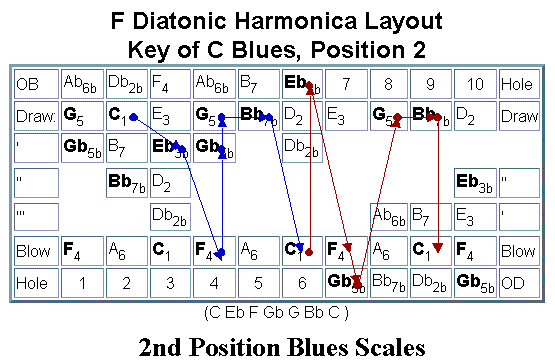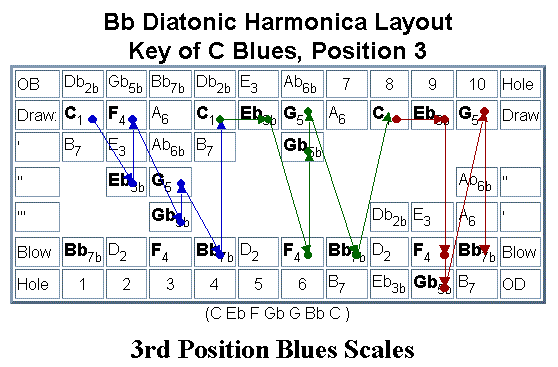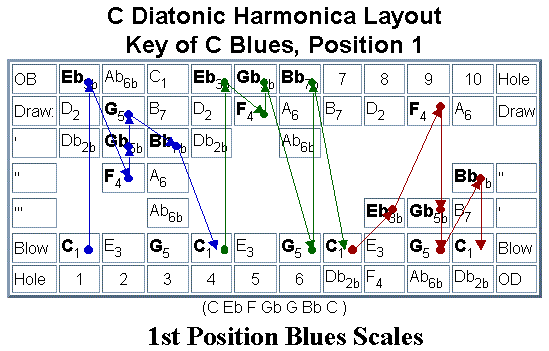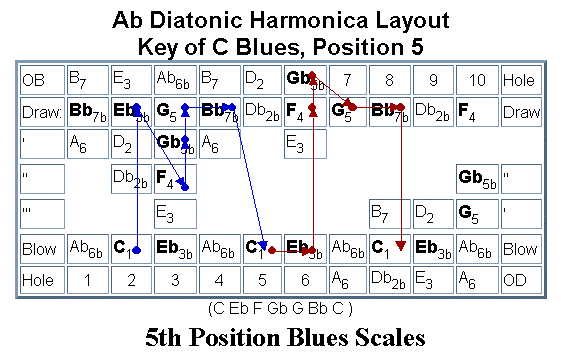The blues is an improvisational form of music. That is, it’s dynamic–you play what you feel and make it up as you go. You can find sheet music and tab for blues songs, and these can be useful helps for learning a particular song. But you have to play from your heart, not from your head. That is, the blues needs to sound spontaneous, not preplanned–even if you’re playing well worn songs.
Listen to enough blues that you can hear the chord changes and anticipate them by feel, without thinking about it. Develop your ear enough to be able to single out and listen to the individual instruments. Playing blues is like communicating in a language.. you need to be able to listen as well as speak, and what you say is better if it fits in the context of the conversation.
Stay in the rhythmic “groove” established mainly by the bass and the drums. Beginning players often worry so much about notes, they forget about the rhythm–but the rhythm is the heart beat of the music, giving it life. It is normally better to make a mistake on a note than a mistake on the rhythm.
The blues consists of numerous phrases (also called “licks” or “riffs”) that follow a question-answer, tension-release form. The initial phrase asks the musical question and establishes some tension. The subsequent phrase releases the tension by answering the question. So, even though the phrases are distinct and separate, they are still related. Listen to the questions asked by the other instruments and how they are answered. Build your improvisational solos in the context of this conversation. Even though you’re playing a solo, you’re first and foremost part of a team of musicians creating the music. Listen to the music. Add to it only to make it better.
How to Play Blues Harmonica?
The Blues Form
If you’re going to play the blues, you have to be thoroughly familiar with the blues form.
Normally the blues is played as a 12 bar chord progression in 4/4 time using the I IV V (one four five) chords of the major scale, normally played as dominant 7th chords (i.e. with the flat 7th added to the basic triad), and melody notes from the blues scale (see below).
The basic 12 bar form is:
- 4 bars of the tonic I chord, (In the key of E that’s an E chord)
- 2 bars of the sub-dominant IV chord, (In the key of E, that’s an A chord)
- 2 more bars of the I chord,
- 1 bar of the dominant V chord, (in the key of E, that’s a B chord)
- 1 bar of the IV chord
- 1 bar of the I chord
- 1 bar of the V chord as a turnaround to start the next verse, or 1 more bar of the I chord to end
- back to the beginning.
Here’s what it looks like in a sort-of lead sheet form, with the key of C shown as an example:

The Blues Scale
The blues scale consists of the most frequent and most emphasized notes used when playing the blues. Learn the scale and lean on those notes, especially on the beat. “Leaning on” the blues scale notes means to use them more frequently and/or play them louder.
The blues scale consists of the following musical scale degrees:
1, b3, 4, b5, 5, b7 8/1.
These are also sometimes called the tonic (1), flat third, sub-dominant (fourth), flat fifth, dominant (5), flat seven, and octave.
For the key of C that’s:
C, Eb, F, Gb, G, Bb, C.
Second Position (aka “Cross Harp”)
Second position is by far and away the most common position used for playing blues, rock, and country music. The blues scale in 2nd position starts on the hole 2 draw. (The hole 3 blow is the same note, but the 2 draw should be used instead, almost always.)
For 2nd position in the low octave the tab is:
2, 3′, 4>, 4′, 4, 5, 6> (2 draw, 3 draw bend, 4 blow, 4 draw bend, 4 draw, 5 draw, 6 blow).
For the high octave in 2nd position the tab is:
6>, 6>#, 7>, 7#, 8, 9, 9>
Here is a diagram of an F harp that shows where the notes in the 2nd position C blues scale are. It doesn’t matter whether you use an F harp or not–it’s just easiest to think in the key of C.

Here is tab for all the notes in the blues scale in 2nd position:
1>, 1′, 1, 2″, 2 and 3>, 3′, 4>, 4′, 4, 5, 6>, 6>#, 7>, 7#, 8, 9, 9>, 10″>, 10>, 10#
Play mostly notes from the blues scale (at first, while learning. Later you’ll figure out that you can use any note, it’s just a matter of how and where). Make sure you play notes from the blues scale on the beat. Try to lean on the notes in the current chord in the I, IV, V chord progression (in C, I=C, IV=F, V=G), especially the I, on the beat.
The first 6 holes are the most used for blues. Holes 2, 3, and 4 are especially important. Work on all the available bends in these holes. Virtually always play hole 3 draw bent, at least a little. It is one of the key “blue notes”, which are the flat 3rd, flat 5th, and flat 7th. The blue notes in 2nd position are located at:
1′ (flat 5), 2″ (flat 7), 3′ (flat 3), 4′ (flat 5), 5 (flat 7), 6># (flat 3), 7# (flat 5), 9 (flat 7), 10>” (flat 3), 10# (flat 5)
Third Position
Blues is also often played in 3rd position as well as 2nd. Where 2nd position (cross harp) starts on the 2 draw, 3rd position starts on the 4 draw, or the 1 draw, where full blues scales are available using only normal draw bends.
Here is tab for the blues scale for 3rd position showing the key of C.
1 2″ 2 3″‘ 3″ 4> 4, 4 5 6> 6’ 6 7> 8, 8 9 9> 9># 10 10>
The following diagram shows a Bb harp with the 3rd position key of C blues scale highlighted, and arrows that show the order of the notes in the scale from low to high.

First Position
Blues can also be played in 1st position, where the key of the harp is the same as the key of the music. First position, or straight harp, starts on the hole 1 blow note. The high end of the harp is expecially good for blues in 1st position because all the notes in the blues scale are available with only normal bends. The middle octave requires 3 overblows, on the 4, 5, and 6 holes, but the low octave only requires the hole 1 overblow for the flat 3rd.
Here are the 1st position blues scales in tab format:
1> 1># 2″ 2′ 2 3′ 4>, 4> 4># 5 5># 6> 6># 7>, 7> 8>’ 9 9>’ 9> 10>” 10>
Here is a diagram of the 1st position scale layout on a C harp:

Fifth Position
Another good position for blues that is used much less often is 5th position. The 6 overblow is needed to complete the blues scale in the middle octave, but that note is the flat 5th, which is the least important note of the blues scale. Leaving it out gives you the pentatonic scale, which is still good for playing blues too.
Here’s the 5th position blues scales tab:
2> 2 3″ 3′ 3 4 5>, 5> 6> 6 6># 7 8 8>

The following diagram shows an Ab harp with the 5th position C blues scale highlighted.
Use the Shuffle Rhythm
Emphasize beats 2 and 4. Clap or tap on the second and forth beat of each measure, not the first and third. Count it like
1 2 3 4.
Instead of a straight beat like “1 and 2 and 3 and 4 and…” it’s more like
“1 hold and2 hold and3 hold and4 hold and1 …”
Put the rhythm in your body and don’t let it die. Prefer to miss a note rather than mess up the beat. Tap your foot. Tap BOTH feet. Tap your heels instead of your toes. Rock from side to side. Put the rhythm in your body!
Use triplets. A triplet divides a rhythmic unit into 3 equal parts, instead of just 2 or 4 etc. For example, “triplet eighths” have 3 notes in the space of 1 beat instead of the usual 2 eighth notes in 1 beat.
Learn your instrument.
You need to be familiar enough with your instrument that you don’t have to think to play it. Learn the techniques you need in order to play the sounds you want. Learn the sounds, where they are and how to get them.
Emphasize tone and emotion more than speed.
Blues is about tone. It’s about feelings and soul. It’s not about how many notes you can play, but about which notes you decide to play… and which ones you decide not to play. Remember, there are no unimportant notes. Make sure each note is played clearly, cleanly, in time, with good tone, and given its proper due.
Leave some space. The rest is a valid musical expression. The silence sets up the sounds; frames them as if they’re a valuable painting. Spaces, like notes, can add musical tension and interest to your phrasing and expression. Very often in blues it is best to subscribe to the philosophy that less is more.
Get the blues in your mind and ear, find something to say, and be able to say it.. clearly and eloquently.
Added by
Harmonica Tabs
WRITE A COMMENT
WRITE A COMMENT



 (2 votes, average: 4.50 out of 5)
(2 votes, average: 4.50 out of 5)



26 Comments